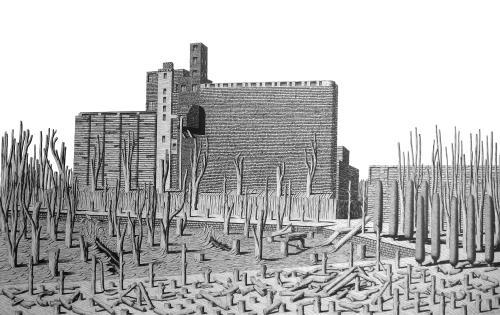By Zoe
I once lived in a purple house in Montreal with some roommates including the Toronto artist and Professor, Luke Painter. They made sure I went to see Arcade Fire for $7, introduced me to Dim Sum and helped me to understand the beginnings of contemporary painting.
Luke has shown drawings and an installation-based works at a number of venues including Angell Gallery in Toronto, Bonneau Samames Art Contemporain in Marseille, France, the Pulse Art Fair in New York and Plus Gallery in Denver. Luke has exhibited with Angell Gallery since 2002 and has been in Art Toonto four times. In 2008, Luke Painter was included in the Carte Blanche 2, a book of contemporary Canadian Painting.
Luke’s willingness to help everyone around him has made him a bit of a legend. To those of us who are lucky enough to have known him over the years, we have seen great growth in his work and a variation and maturity in his art practice. He works really hard and makes things happen.
Zoe Pawlak: In recent works we see a merging of new and old, the antiquated and that which has the appearance of being futuristic. How does the convergence of past and future imagery play into your work?
Luke Painter: Over the past few years I have been working on large-scale paintings rendered with India ink and brush on paper that utilize disparate elements within figures and landscapes to create a sense of historical ambiguity. These works are intentionally mimetic of traditional printmaking techniques (woodcut, engraving) and composite methods used in digital media (Photoshop), but the end result is a singular work on paper. I am interested in combining older forms of ornamentation and patterning with contemporary subject matter and/or modern looking individuals.
ZP: You have lived in both Montreal and Toronto. Having grown up in Toronto and now living there as an adult and an artist, what influences are you taking most from the city itself?
LP: I am deeply affected by the city I live in and I often incorporate aspects of my surroundings into my work. In one of my drawings titled, The Harbour (Malting), I have used an old grain silo as a reference for this particular work. This grain silo is located on Queens Quay near Bathurst St in Toronto and is one of two remaining silos originally built in 1928 that was used to store malt. Built from concrete, the stripped-down and unadorned functionalism of the building was a precursor to modernist trends in architecture. It has been unused since the 1980’s and there has been debate about how the site should be utilized, with talk of a museum or theme park. I grew up in this neighborhood, which has been quickly developed into a condo landscape. Canada Malting has now become an interesting anomaly in the midst of accelerated development. My own interest in the building comes from a desire to reformulate the material of the building back to wood, in which they were originally built (they were changed to concrete to avoid burning down). I decided to take the concept one step further by rendering the surrounding area in wood to amplify the once natural surroundings that populated this area around Lake Ontario. I imagine Canada Malting to be an eyesore for many of the new condo residents, but it continues to hold a personal resonance with me as I grew up nearby.
ZP: Toronto has really been gaining international attention for events like Nuit Blanche and Art Toronto. What have these events meant to Toronto’s working artists like yourself?
LP: Having just witnessed this years Nuit Blanche I have to say that I really like the event. For many people I know it is art-lite or art that is for entertainment and not for contemplation. I personally think it can be both. Both Art Toronto and Nuit Blanche have been good for raising awareness about the Toronto scene in international circles.
ZP: In 2008, you received a Canadian Council Artist Grant. What did you make with this grant and what does it mean to be supported in this way?
LP: In 2008 I received a Canada Council Artist Grant for a work titled From Victorian to Modernism to What? This installation shown in May 2010 at 47 Space in Toronto reflected on the compulsion to personally connect with (and often transform) the architecture of our surroundings. Over the past couple of years I worked with my father to build a scale model of a specific Victorian house from a neighbourhood where we both used to live.
Approximately 8’ tall and heavily ornamented, the structure is too small
to be a real house and too large to be a dollhouse. On the rear wall
of the building, two eyes made from stained glass project animations
depicting architectural sites specific to Toronto that have personal
resonance with me and that nod to the transitioning nature of
neighbourhoods in the city. It was an important project for me. I started to think about larger works with bigger budgets and I am now starting to apply for some more ambitious projects.
LP: I am deeply affected by the city I live in and I often incorporate aspects of my surroundings into my work. In one of my drawings titled, The Harbour (Malting), I have used an old grain silo as a reference for this particular work. This grain silo is located on Queens Quay near Bathurst St in Toronto and is one of two remaining silos originally built in 1928 that was used to store malt. Built from concrete, the stripped-down and unadorned functionalism of the building was a precursor to modernist trends in architecture. It has been unused since the 1980’s and there has been debate about how the site should be utilized, with talk of a museum or theme park. I grew up in this neighborhood, which has been quickly developed into a condo landscape. Canada Malting has now become an interesting anomaly in the midst of accelerated development. My own interest in the building comes from a desire to reformulate the material of the building back to wood, in which they were originally built (they were changed to concrete to avoid burning down). I decided to take the concept one step further by rendering the surrounding area in wood to amplify the once natural surroundings that populated this area around Lake Ontario. I imagine Canada Malting to be an eyesore for many of the new condo residents, but it continues to hold a personal resonance with me as I grew up nearby.
ZP: Toronto has really been gaining international attention for events like Nuit Blanche and Art Toronto. What have these events meant to Toronto’s working artists like yourself?
LP: Having just witnessed this years Nuit Blanche I have to say that I really like the event. For many people I know it is art-lite or art that is for entertainment and not for contemplation. I personally think it can be both. Both Art Toronto and Nuit Blanche have been good for raising awareness about the Toronto scene in international circles.
















